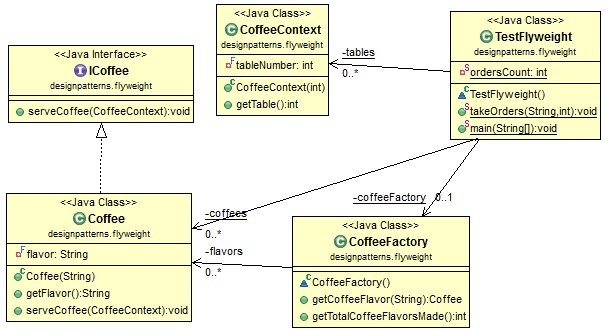(文章翻译自Java Design Pattern: Flyweight)
享元模式用于最小化内存开销。它做的就是使用其他相似的对象尽可能多的分享数据。
1.享元模式类图

2.享元模式Java代码
// Flyweight object interface
interface ICoffee {
public void serveCoffee(CoffeeContext context);
}
// Concrete Flyweight object
class Coffee implements ICoffee {
private final String flavor;
public Coffee(String newFlavor) {
this.flavor = newFlavor;
System.out.println("Coffee is created! - " + flavor);
}
public String getFlavor() {
return this.flavor;
}
public void serveCoffee(CoffeeContext context) {
System.out.println("Serving " + flavor + " to table " + context.getTable());
}
}
// A context, here is table number
class CoffeeContext {
private final int tableNumber;
public CoffeeContext(int tableNumber) {
this.tableNumber = tableNumber;
}
public int getTable() {
return this.tableNumber;
}
}
CoffeeFactory:它只是在需要的时候才会创建一个新的咖啡。
//The FlyweightFactory!
class CoffeeFactory {
private HashMap<String, Coffee> flavors = new HashMap<String, Coffee>();
public Coffee getCoffeeFlavor(String flavorName) {
Coffee flavor = flavors.get(flavorName);
if (flavor == null) {
flavor = new Coffee(flavorName);
flavors.put(flavorName, flavor);
}
return flavor;
}
public int getTotalCoffeeFlavorsMade() {
return flavors.size();
}
}
//服务员上咖啡
public class Waitress {
//coffee array
private static Coffee[] coffees = new Coffee[20];
//table array
private static CoffeeContext[] tables = new CoffeeContext[20];
private static int ordersCount = 0;
private static CoffeeFactory coffeeFactory;
public static void takeOrder(String flavorIn, int table) {
coffees[ordersCount] = coffeeFactory.getCoffeeFlavor(flavorIn);
tables[ordersCount] = new CoffeeContext(table);
ordersCount++;
}
public static void main(String[] args) {
coffeeFactory = new CoffeeFactory();
takeOrder("Cappuccino", 2);
takeOrder("Cappuccino", 2);
takeOrder("Regular Coffee", 1);
takeOrder("Regular Coffee", 2);
takeOrder("Regular Coffee", 3);
takeOrder("Regular Coffee", 4);
takeOrder("Cappuccino", 4);
takeOrder("Cappuccino", 5);
takeOrder("Regular Coffee", 3);
takeOrder("Cappuccino", 3);
for (int i = 0; i < ordersCount; ++i) {
coffees[i].serveCoffee(tables[i]);
}
System.out.println("
Total Coffee objects made: " + coffeeFactory.getTotalCoffeeFlavorsMade());
}
}
检查下面的结果输出,虽然有十个桌子需要咖啡可是只生产了两种咖啡。
Coffee is created! - Cappuccino
Coffee is created! - Regular Coffee
Serving Cappuccino to table 2
Serving Cappuccino to table 2
Serving Regular Coffee to table 1
Serving Regular Coffee to table 2
Serving Regular Coffee to table 3
Serving Regular Coffee to table 4
Serving Cappuccino to table 4
Serving Cappuccino to table 5
Serving Regular Coffee to table 3
Serving Cappuccino to table 3
Total Coffee objects made: 2